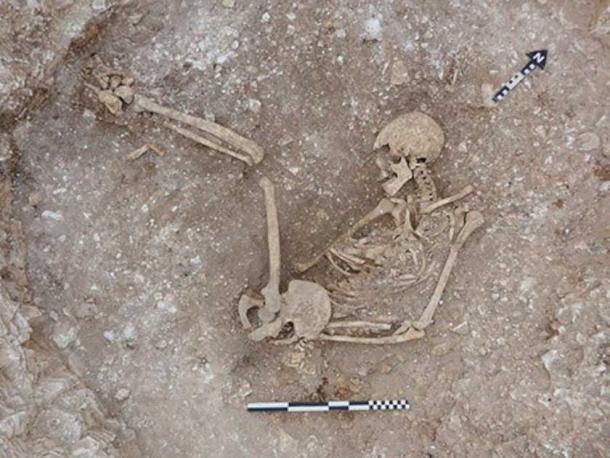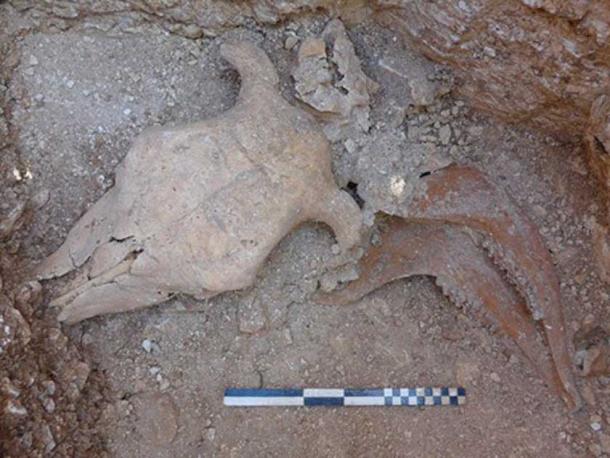
Sacrifice Remains From 100 BC Dug Up At ‘Duropolis’, Dorset
A team of 65 Bournemouth University archaeology students exploring an Iron Age site in Dorset County in southwest England have been credited with a significant discovery. While digging at a location dubbed Duropolis, near the village of Winterborne Kingston last September, they found human and animal skeletons buried in deep pits that had originally been dug to store grain.
The site in Dorset has been extensively investigated, and positively identified as the equivalent of a residential neighborhood on the outskirts of a larger settlement that would have been occupied sometime around the year 100 BC. Student and professional archaeologists working at the site have unearthed the ruins of many round houses, which were the typical dwellings of Iron Age people, along with a multitude of storage pits.
Some of the latter were used exclusively for storage, but some were repurposed as graves at some point, as the way the site was used changed over time.
“Sites across Dorset in the Late Iron Age are unique because the communities here buried their dead in defined cemeteries,” Bournemouth archaeologist and excavation leader Dr. Miles Russell explained, in a press release issued by his university. “Elsewhere in the country they would either be cremated or placed in rivers, but in Dorset it seems they did things rather differently.”
The Iron Age in Britain began in approximately 750 BC and continued until the Romans invaded in 43 AD, which is why Dr. Russell refers to sites found in Dorset as ‘Late Iron Age.’
- Roman Slave of Britannia, Shackled, And Thrown In A Ditch To Die
- Roman Fort Used During Conquest of Britain Found in the Netherlands

A human skeleton in an oval pit at Duropolis. (Bournemouth University)
Duropolis and “Urban Sprawl” in the Iron Age
Inside the freshly excavated pits, the archaeology students dug out several human skeletons that had been placed carefully in crouched positions. The deliberate positioning of the bodies would have had a specific religious purpose, although the archaeologists aren’t sure what that might be at the present time.
The bodies were interred along with a selection of grave goods, specifically food and beverages that were apparently intended to be gifts to the gods.
The food consisted of meat from a variety of animals, revealed by animal bones and joints found inside the burial pits. No traces of any liquid drinks were found, but the archaeologists have deduced that such drinks were once there based on the presence of pottery bowls placed beside the deceased.
The members of the archaeological team were shocked to discover so many animal remains buried alongside those of humans.
“The animal remains that we’re finding placed in the bottom of pits would have provided weeks of food for this settlement,” Dr. Russell confirmed. “So it’s a significant sacrifice to their gods to bury so much in the ground.”
- Gas Pipe Workers Accidentally Unearth Chilca Culture Burial in Peru
- Early Medieval Europe – Dark Age Death Practices Spread Quickly

A cow skull, vertebrae and jaw bones. (Bournemouth University)
There were ritual elements to the animal sacrifices that help legitimize the idea they had a spiritual purpose. In some of the pits, the animal parts and bones of different species were intermingled. In one grave, for example, the archaeological students found a cow’s head placed on the body of a sheep.
“We don’t know why they would have done this, to us it’s frankly bizarre, but it’s a fascinating new insight into their belief systems,” Dr. Russell said.
The area where the grave and sacrifice pits were found is just a half-mile (0.8 kilometers) north of a large Iron Age settlement that was first discovered in 2015. Remnants of more than 150 roundhouses were found at the original site, indicating that it had been densely populated (relative to the standards of its time). Bournemouth staff members and students eventually decided to call the settlement “Duropolis,” which is a name derived from the Durotriges tribes that lived in what is now southwestern England during the Iron Age.
No one knew what might be unearthed if the archaeologists extended their dig zone past the boundaries of the settlement found in 2015. But as the excavation of the graveyard and sacrifice remains shows, the Durotriges tribes that built Duropolis more than 2,000 years ago were no strangers to the concept of sprawl. Their version of a city was constantly expanding its borders, just like the cities of today.
Solving the Mysteries of England’s Ancient Inhabitants
This startling discovery has shed a new light on the burial rituals and practices of Iron Age Britons. Archaeologists and ancient historians are constantly on the lookout for any artifacts or ruins that can be traced back to pre-Roman times, as they seek to fill in some huge gaps in their knowledge of ancient life.
“We know a lot about life in Britain during and after the Roman invasion because so much has been written down,” said Dr. Russell. “But we do not have anything written about life before, the answers to how they lived come solely from what we find in the ground.”
In addition to the animal and human bones, some cultural artifacts have also been recovered during the latest excavations.
“Some of the most exciting finds we have excavated from the dig include a ring that we found on someone’s finger in an associated burial,” said archaeology student Nathan Sue, who has been working on the preservation of all the site’s artifacts. “It is a copper alloy, perhaps bronze and it’s nice to find that as rings of this age are not common.”
The students have been digging up all the storage pits, those with skeletons and those without. Along with the bones of the deceased, they’ve also recovered pottery, charcoal, jewelry pieces and flint. Some of the pits were used exclusively for garbage, which can often include a wide range of remains that illuminate cultural beliefs and activities.
The excavation at the ancient graveyard will continue for a few more days, as archaeologists remain eager and anxious to learn more about the mysterious peoples of pre-Roman Britain. After the recovered human bones have been analyzed, they will be reburied in the ground, in the same spots from which they were recovered.
Top image: Archaeologists excavating a grave at the recently discovered graveyard at the ‘Duropolis’ site in Dorset, England. Source: Bournemouth University
By Nathan Falde
















Comments
So we’re supposed to believe the people of that era DUG PITS to store grain? Would they do that today? When were barns invented? Those go up fast. How long would it take to dig those pits? Which ancient texts describe that massive effort?
No, those were the living-space caverns of the pre-Ice Age civilization, wiped out along with Atlantis, circa 115k BC, adding the zero back to Plato’s timeline.
Nobody gets paid to tell the truth.
Interesting archaeology, but not all that useful, other than making people feel that we have progressed away from human sacrifices when we haven't. Child sacrifice is commonplace today amongst Occult elites.
Some of us know. Most prefer to live in ignorance, while thinking the opposite to be the case.